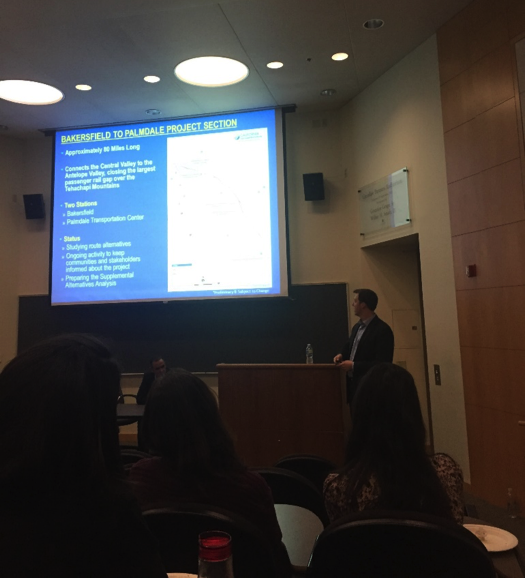News | METRANS Co-Hosts Student Seminar Featuring Planning Representatives from the California HSR Project
Stop the VideoNews

METRANS UTC
METRANS Co-Hosts Student Seminar Featuring Planning Representatives from the California HSR Project
Saturday, March 12, 2016
by By Griffin Kantz, B.S. in Policy, Planning, and Development, 2017.
On February 19, 2016, METRANS Transportation Center co-sponsored a special student-professional event with the University of Southern California chapters of the American Planning Association and Institute of Transportation Engineers. The event featured a panel of professionals from WSP | Parsons Brinckerhoff working on the California High-Speed Rail project:
- Kevin Alvarado, Communications and Public Involvement Specialist for the California High-Speed Rail Authority’s Rail Delivery Partner (RDP) team;
- Karl Fielding, Lead Planner at Parsons for the RDP team;
- and Tony Mendoza, Senior Level Planning Manager at Parsons and Southern California Regional Planning Manager for the California High-Speed Rail project.

Fielding (USC MPL 2015) presenting design specifics of the Bakersfield to Palmdale segment plan. Photo credit: Anna Lee, president of the American Planning Association USC student chapter.
The panelists presented the project goals and progress of California High-Speed Rail (HSR), providing a detailed focus on proposed Southern California corridor segments. Fielding summarized recent developments in grade crossing elimination, community stakeholder engagement, and preliminary engineering data collection in the San Fernando Valley, where the rail corridor is planned to enter the Los Angeles Basin from Palmdale. The California High-Speed Rail Authority recently announced its intent to forestall planning of this segment of the rail corridor in favor of other project segments closer to the Bay Area, due to a lack of consensus among local stakeholders on the best route alignment through the San Gabriel Mountains. Lastly, Alvarado described recent outreach efforts by the Authority to support upstart HSR student advocacy groups using the #IWillRide banner.
Following the presentation, all three professionals took questions from the students in attendance. A detailed discussion on service specifics such as average train speed, scheduling, passenger capacity, and ticket cost followed. The guests also engaged a discussion of HSR’s modal competitiveness versus newly-emergent technologies such as hyperloop and maglev. Fielding and Mendoza cited a five-decade safety precedent, large seating capacity, and the potential for connections to existing freight networks as their and their peers’ reasons for trusting HSR, but noted that new technologies such as hyperloop will become vital mode alternatives for future regional transportation projects.
The California High-Speed Rail project was born from state Proposition 1A (2008), which authorizes up to $9 billion in bond funds for the construction of a HSR corridor between San Francisco, Fresno, Bakersfield, Palmdale, and Los Angeles as well as $950 million in funds for local transit improvements. Planning and funding allocation for the corridor are now under control of the California High-Speed Rail Authority, although specific route segments are constructed by multipole contractors such as WSP | Parsons Brinckerhoff. The Authority plans to complete construction on a $20.7 billion initial operating HSR segment between San Jose and Bakersfield by 2024 and commence operations the following year.
Griffin Kantz
Griffin is a third year undergraduate studying Sustainable Planning in the USC Price School of Public Policy. He can be reached at [email protected].
News Archive
- December (1)
- November (6)
- October (4)
- September (2)
- August (3)
- July (4)
- June (3)
- May (7)
- April (8)
- March (11)
- February (8)
- January (7)
- December (7)
- November (8)
- October (11)
- September (11)
- August (4)
- July (10)
- June (9)
- May (2)
- April (12)
- March (8)
- February (7)
- January (11)
- December (11)
- November (5)
- October (16)
- September (7)
- August (5)
- July (13)
- June (5)
- May (5)
- April (7)
- March (5)
- February (3)
- January (4)
- December (4)
- November (5)
- October (5)
- September (4)
- August (4)
- July (6)
- June (8)
- May (4)
- April (6)
- March (6)
- February (7)
- January (7)
- December (8)
- November (8)
- October (8)
- September (15)
- August (5)
- July (6)
- June (7)
- May (5)
- April (8)
- March (7)
- February (10)
- January (12)















